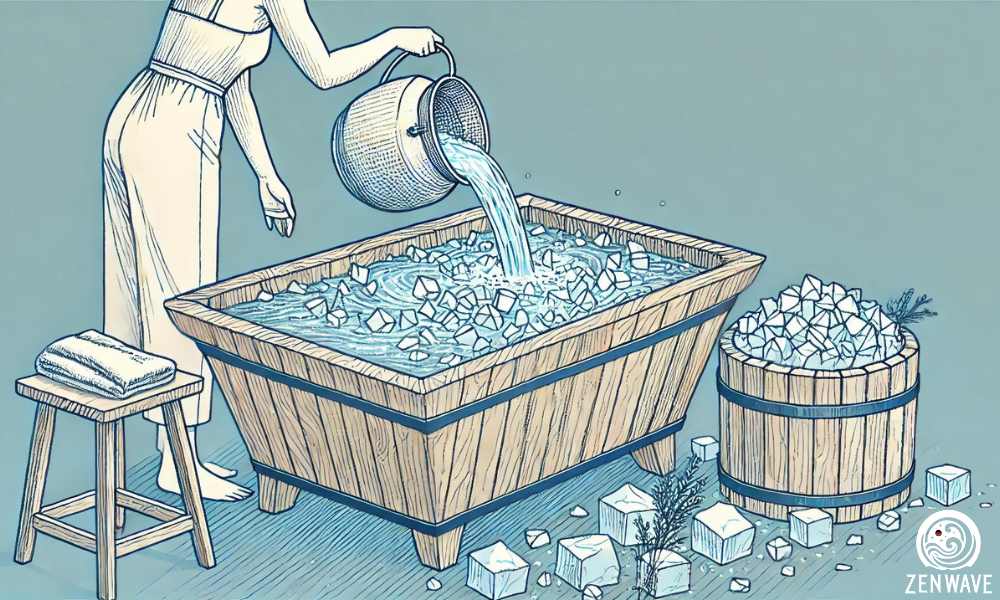Picture this: You’ve just finished an intense workout, and you’re ready to plunge into your ice bath for some sweet relief. But as you approach, you notice the water looks a bit… off. What’s going on in there? Let’s dive into the fascinating world of water contamination and pH balance in ice baths.
Don’t worry – it’s cooler than you might think!
The Uninvited Guests: Understanding Contamination
Your ice bath is like an exclusive party, and sometimes uninvited guests try to crash. These party crashers come in three main forms:
- Body Buddies: Every time you hop in, you bring along some microscopic friends – oils from your skin, a bit of sweat, and even tiny flakes of dead skin. It’s totally normal and happens to everyone, so don’t sweat it (pun intended)!
- Nature’s Confetti: If your tub is outdoors, Mother Nature likes to join in on the fun. Dust, pollen, and the occasional curious insect might drop by for a quick dip. Think of it as the great outdoors wanting to chill with you.
- Microscopic Mischief-Makers: These are the tiniest guests of all – bacteria, algae, and fungi. You can’t see them, but they’re always looking for a nice place to multiply. Consider them the uninvited party planners trying to turn your chill session into their own little fiesta.
Why Keeping It Clean Is Cool
Now, you might be wondering, “So what if my ice bath has a few extra ‘guests’?” Well, keeping these uninvited attendees in check is crucial for a few important reasons:
- Skin Safety: Nobody wants to leave their ice bath with an unwelcome souvenir like a skin rash or infection. Clean water keeps your skin happy and healthy.
- Breathe Easy: When you’re taking those deep, invigorating breaths during your ice bath, you want to ensure you’re not inhaling any nasty stuff. Clean water means clean air above it.
- Maximum Chill: Believe it or not, a layer of gunk in your tub can actually insulate the water, making your ice bath less effective. It’s like trying to chill a drink with lukewarm ice – not cool, right?
The pH Puzzle: Finding the Right Balance
Now, let’s talk about pH. If you’re having flashbacks to high school chemistry, don’t worry – we’ll keep it simple and fun!
Think of pH as your water’s mood ring:
- A pH of 7 is neutral – your water is feeling perfectly zen.
- Below 7, it’s acidic – your water’s feeling a bit sour and feisty.
- Above 7, it’s alkaline – your water’s in a basic mood (and we don’t mean basic as in pumpkin spice lattes).
For your ice bath, we want to keep things just right – usually between 7.2 and 7.6. It’s like Goldilocks: not too acidic, not too alkaline, but just right.
The Bacterial See-Saw: A Microscopic Balancing Act
Here’s where it gets really interesting. Bacteria and pH play a constant game of see-saw in your ice bath:
- Bacteria move in and start to grow, having a little party in your tub.
- As they party hardy, they leave behind acidic waste – lowering the pH of your water.
- This new, more acidic environment is like a cozy blanket for certain types of bacteria. They love it!
- More bacteria grow, making things even more acidic.
- The cycle continues until your tub is basically a bacterial playground.
But don’t panic! This process doesn’t happen overnight, and there’s plenty you can do to keep things in check.
The Impact of Imbalance: When Good Baths Go Bad
So what happens if we let our little bacterial friends run wild and the pH gets out of whack? A few things:
- Skin Irritation: Water that’s too acidic or too alkaline can irritate your skin. It might feel itchy, dry, or even burn slightly. Not exactly the refreshing experience you’re after!
- Reduced Effectiveness: Remember how we said gunk can insulate your water? An imbalanced pH can contribute to this problem, making your ice bath less cold and less effective.
- Equipment Damage: Over time, water with an improper pH balance can damage your tub or any equipment you use, like filters or pumps. It’s like feeding your ice bath setup a steady diet of junk food – not good for its long-term health.
- Increased Contamination Risk: An imbalanced pH creates a more favorable environment for harmful bacteria and algae to grow. It’s like rolling out the red carpet for all the wrong guests.
Keeping Your Cool: Simple Steps for a Clean Bath
Now that you understand the what and why of water contamination and pH balance, you’re probably wondering about the how. How do you keep your ice bath clean and perfectly balanced? Here are a few simple steps:
- Regular Testing: Get yourself some pH testing strips. They’re cheap, easy to use, and will give you a quick read on your water’s mood.
- Shower Before Dipping: A quick rinse before you hop in can significantly reduce the number of “body buddies” you introduce to your bath.
- Cover Up: When you’re not using your ice bath, keep it covered. This will help keep out Nature’s confetti.
- Proper Treatment: Use appropriate water treatment methods like chlorine, pH balancers, hydrogen peroxide, or UV sterilization.
- Regular Cleaning: Drain and clean your tub regularly. Think of it as a spa day for your ice bath!
Conclusion: Mastering the Art of the Chill
Understanding water contamination and pH balance might seem like a lot, but it’s an essential part of maintaining a safe and effective ice bath practice. By keeping an eye on these factors, you’re ensuring that every dip is as refreshing and beneficial as possible.
Remember, a clean ice bath is a happy ice bath. And a happy ice bath means a happier, healthier you. So go forth, armed with this knowledge, and be the ultimate ice bath party host – where only the invited guests (that’s you!) get to enjoy the cool, clean waters. Stay chill, friends!

